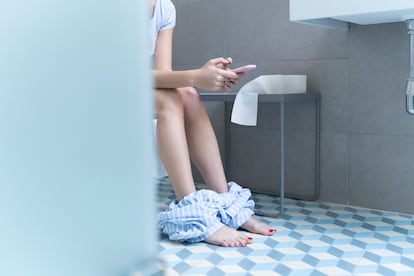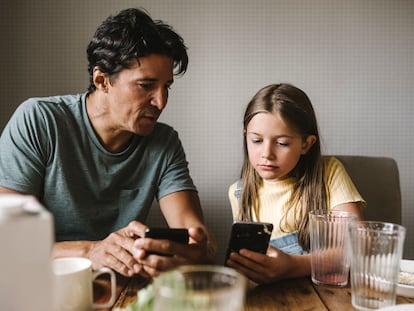The dirty truth about your phone – and why you need to stop scrolling in the bathroom
The microbial infection risk of your cellphone is much less appreciated than the other health concerns about the device, but it’s very real

We carry them everywhere, take them to bed, to the bathroom and for many people they’re the first thing they see in the morning — more than 90% of the world owns or uses a cellphone and many of us couldn’t manage without one.
But while health concerns about phones use usually focus on the distraction they can cause while driving, the possible effects of radiofrequency exposure, or just how addictive they can be. The microbial infection risk of your phone is much less appreciated — but it’s very real.
A 2019 survey found that most people in the U.K. use their phones on the toilet. So it’s not surprising to discover studies have found our cellphones to be dirtier than toilet seats.
We give our phones to children to play with (who aren’t exactly well known for their hygiene). We also eat while using our phones and put them down on all sorts of (dirty) surfaces. All of which can transfer microbes onto your phone along with food deposits for those microbes to eat.
It’s been estimated that people touch their phone hundreds if not thousands of times a day. And while many of us wash our hands regularly after say, going to the bathroom, cooking, cleaning, or gardening, we are much less likely to consider washing our hands after touching our phones. But given how disgusting and germ-infested phones can be, maybe it’s time to think more about mobile phone hygiene.
Germs, bacteria, viruses
Hands pick up bacteria and viruses all the time and are recognized as a route for acquiring infection. So too are the phones we touch. A number of studies conducted on the microbiological colonization of mobile phones show that they can be contaminated with many different kinds of potentially pathogenic bacteria.
These include the diarrhoea-inducing E. coli (which, by the way, comes from human poo) and the skin-infecting Staphylococcus, as well as Actinobacteria, which can cause tuberculosis and diphtheria, Citrobacter, which can lead to painful urinary tract infections, and Enterococcus, which is known to cause meningitis. Klebsiella, Micrococcus, Proteus, Pseudomonas and Streptococcus have also been found on phones and all can have equally nasty effects on humans.
Research has found that many pathogens on phones are often antibiotic resistant, meaning they can’t be treated with conventional drugs. This is worrying as these bacteria can cause skin, gut and respiratory infections that can be life-threatening.
Research has also found that even if you clean your phone with antibacterial wipes or alcohol it can still be recolonized by microorganisms, indicating that sanitization must be a regular process.
Phones contain plastic which can harbour and transmit viruses some of which (the common cold virus) can live on hard plastic surfaces for up to a week. Other viruses such as Covid-19, rotavirus (a highly infectious stomach bug that typically affects babies and young children), influenza and norovirus — which can cause serious respiratory and gut infections — can persist in an infectable form for several days.
Indeed, since the beginning of the Covid pandemic, the U.S. Centers for Disease Control and Prevention has introduced guidelines for cleaning and disinfecting mobile phones — which, along with door handles, cash machines and lift buttons, are considered reservoirs of infection.
In particular, concern has been raised about the role mobile phones can play in the spread of infectious microbes in hospital and healthcare settings, as well as in schools.
Clean your phone
So it’s clear that you need to start cleaning your phone regularly. The U.S. Federal Communications Commission actually recommends daily sanitation of your phone and other devices — not least because we are still within an active Covid-19 pandemic and the virus can survive for several days on hard plastic surfaces.
Use alcohol-based wipes or sprays. They need to contain at least 70% alcohol to disinfect phone casings and touch screens, and it needs to be done every day if possible.
Do not spray sanitizers directly onto the phone and keep liquids away from connection points or other phone openings. Absolutely avoid using bleach or abrasive cleaners. And wash your hands thoroughly after you’ve finished cleaning.
Thinking about how you handle your phone will also help to avoid it becoming colonized with germs. When not at home, keep your phone in your pocket, or bag and use a disposable paper list of to-do items, rather than constantly consulting your phone. Touch your phone with clean hands — washed with soap and water or disinfected with alcohol-based hand sanitizer.
There are other things you can do to avoid your phone becoming a source of viruses. Do not share your phone with others if you have any infection, or have not first sanitized it. If children are allowed to play with your phone, sanitize it as soon as possible afterwards.
And get in the habit of putting your phone away when not in use, then sanitizing or washing your hands. You might also want to occasionally sanitize your phone charger when you are cleaning your phone.
Primrose Freestone is Senior Lecturer in Clinical Microbiology at the University of Leicester.
This article was originally published on The Conversation.
Sign up for our weekly newsletter to get more English-language news coverage from EL PAÍS USA Edition
Tu suscripción se está usando en otro dispositivo
¿Quieres añadir otro usuario a tu suscripción?
Si continúas leyendo en este dispositivo, no se podrá leer en el otro.
FlechaTu suscripción se está usando en otro dispositivo y solo puedes acceder a EL PAÍS desde un dispositivo a la vez.
Si quieres compartir tu cuenta, cambia tu suscripción a la modalidad Premium, así podrás añadir otro usuario. Cada uno accederá con su propia cuenta de email, lo que os permitirá personalizar vuestra experiencia en EL PAÍS.
¿Tienes una suscripción de empresa? Accede aquí para contratar más cuentas.
En el caso de no saber quién está usando tu cuenta, te recomendamos cambiar tu contraseña aquí.
Si decides continuar compartiendo tu cuenta, este mensaje se mostrará en tu dispositivo y en el de la otra persona que está usando tu cuenta de forma indefinida, afectando a tu experiencia de lectura. Puedes consultar aquí los términos y condiciones de la suscripción digital.
More information
Archived In
Últimas noticias
NASA discovers Titan doesn’t have an ocean, but a ‘slushy ice layer’ that increases possibility of life
Innocence lost in the forest of the child soldiers: ‘Each leader of the armed group had his girls’
‘Fallout’ or how the world’s largest company turned an anti-capitalist apocalyptic Western into a phenomenon
From inflation to defending migrants: Eileen Higgins and Zohran Mamdani inaugurate the new Democratic resistance against Trump
Most viewed
- ‘El Limones’ and the growing union disguise of Mexican organized crime
- Christian Louboutin: ‘Young people don’t want to be like their parents. And if their parents wear sneakers, they’re going to look for something else’
- The low-cost creative revolution: How technology is making art accessible to everyone
- ‘We are dying’: Cuba sinks into a health crisis amid medicine shortages and misdiagnosis
- A mountaineer, accused of manslaughter for the death of his partner during a climb: He silenced his phone and refused a helicopter rescue










































